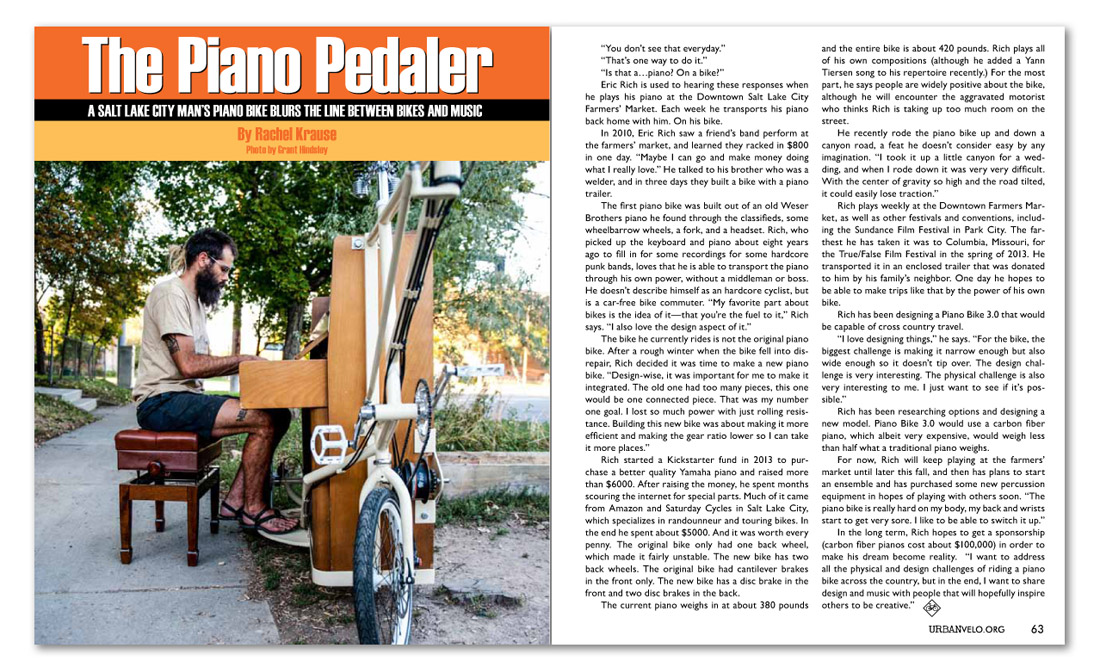


The Piano Pedaler
Rachel Krause
A Salt Lake City man’s piano bike blurs the line between bikes and music.
“You don’t see that everyday.”
“That’s one way to do it.”
“Is that a…piano? On a bike?”
Eric Rich is used to hearing these responses when he plays his piano at the Downtown Salt Lake City Farmers’ Market. Each week he transports his piano back home with him. On his bike.
In 2010, Eric Rich saw a friend’s band perform at the farmers’ market, and learned they racked in $800 in one day. “Maybe I can go and make money doing what I really love.” He talked to his brother who was a welder, and in three days they built a bike with a piano trailer.
The first piano bike was built out of an old Weser Brothers piano he found through the classifieds, some wheelbarrow wheels, a fork, and a headset. Rich, who picked up the keyboard and piano about eight years ago to fill in for some recordings for some hardcore punk bands, loves that he is able to transport the piano through his own power, without a middleman or boss. He doesn’t describe himself as an hardcore cyclist, but is a car-free bike commuter. “My favorite part about bikes is the idea of it—that you’re the fuel to it,” Rich says. “I also love the design aspect of it.”
The bike he currently rides is not the original piano bike. After a rough winter when the bike fell into disrepair, Rich decided it was time to make a new piano bike. “Design-wise, it was important for me to make it integrated. The old one had too many pieces, this one would be one connected piece. That was my number one goal. I lost so much power with just rolling resistance. Building this new bike was about making it more efficient and making the gear ratio lower so I can take it more places.”
Rich started a Kickstarter fund in 2013 to purchase a better quality Yamaha piano and raised more than $6000. After raising the money, he spent months scouring the internet for special parts. Much of it came from Amazon and Saturday Cycles in Salt Lake City, which specializes in randounneur and touring bikes. In the end he spent about $5000. And it was worth every penny. The original bike only had one back wheel, which made it fairly unstable. The new bike has two back wheels. The original bike had cantilever brakes in the front only. The new bike has a disc brake in the front and two disc brakes in the back.
The current piano weighs in at about 380 pounds and the entire bike is about 420 pounds. Rich plays all of his own compositions (although he added a Yann Tiersen song to his repertoire recently.) For the most part, he says people are widely positive about the bike, although he will encounter the aggravated motorist who thinks Rich is taking up too much room on the street.
He recently rode the piano bike up and down a canyon road, a feat he doesn’t consider easy by any imagination. “I took it up a little canyon for a wedding, and when I rode down it was very very difficult. With the center of gravity so high and the road tilted, it could easily lose traction.”
Rich plays weekly at the Downtown Farmers Market, as well as other festivals and conventions, including the Sundance Film Festival in Park City. The farthest he has taken it was to Columbia, Missouri, for the True/False Film Festival in the spring of 2013. He transported it in an enclosed trailer that was donated to him by his family’s neighbor. One day he hopes to be able to make trips like that by the power of his own bike.
Rich has been designing a Piano Bike 3.0 that would be capable of cross country travel.
“I love designing things,” he says. “For the bike, the biggest challenge is making it narrow enough but also wide enough so it doesn’t tip over. The design challenge is very interesting. The physical challenge is also very interesting to me. I just want to see if it’s possible.”
Rich has been researching options and designing a new model. Piano Bike 3.0 would use a carbon fiber piano, which albeit very expensive, would weigh less than half what a traditional piano weighs.
For now, Rich will keep playing at the farmers’ market until later this fall, and then has plans to start an ensemble and has purchased some new percussion equipment in hopes of playing with others soon. “The piano bike is really hard on my body, my back and wrists start to get very sore. I like to be able to switch it up.”
In the long term, Rich hopes to get a sponsorship (carbon fiber pianos cost about $100,000) in order to make his dream become reality. “I want to address all the physical and design challenges of riding a piano bike across the country, but in the end, I want to share design and music with people that will hopefully inspire others to be creative.”